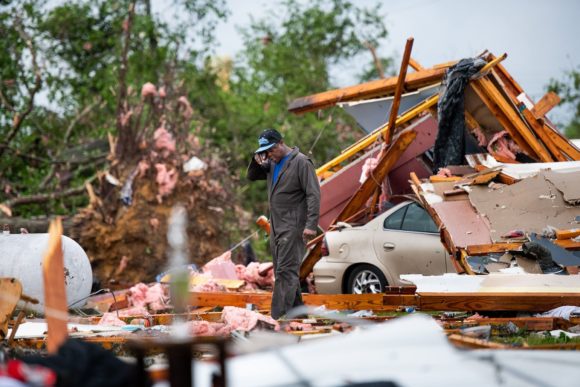By mid-Monday morning, storms sweeping north from the Gulf Coast had left more than 1.3 million out of power in the U.S. Under normal circumstances, this would have called for the mass mobilization of crews to get the lights back on. But not this time.
For years, when the power went out in one region due to a natural disaster or other catastrophic event, workers from elsewhere would rush in to help restore the grid. Due to government-issued stay-at-home orders and the overhanging threat of Covid-19, however, utilities have had to curtail or even suspend longstanding mutual assistance pacts.
“This industry is built on the expectation of helping each other in times of need,” says Scott Aaronson, vice president of security and preparedness for Edison Electric Institute (EEI). Now Aaronson is instructing plant managers: “Plan as though you don’t get outside help.”
At least 10 U.S. utility workers have already died in the pandemic, according to a union official. A council of industry leaders that helps utilities work with the federal government to plan for disasters is advising companies to avoid sending crews into areas with significant outbreaks and to limit contact between workers from different regions. All of that means that as climate change makes storms fiercer and more frequent, it’s going to take longer to turn the power back on.
This spring already feels different for Kris Anderson, a former lineman with Duquesne Light Co. in Pittsburgh, who helped repair equipment in northwest Pennsylvania and New Jersey after Hurricane Sandy. That storm cut off power to more than 8.5 million customers in 21 states, prompting the biggest mutual-assistance response ever. More than 57,000 crews of workers from across North America were deployed, but even so, more than 800,000 were still without power more than a week later.
“FEMA should be worried about what will happen if there’s a heavy storm season,” says Anderson, who now works full time at the International Brotherhood of Electrical Workers union. “They’re already spread pretty thin.”
A spokesperson for the Federal Emergency Management Agency rejected the idea that it won’t be able to respond fully to this year’s storm season last month in an interview with Bloomberg News. However officials at the state and local level are still worried—both about the agency’s preparedness and their own.
The storm that battered the U.S. this week unleashed tornadoes in the Carolinas, Mississippi and elsewhere. By Tuesday afternoon, there were still 250,000 homes and businesses without power from Texas to Maine, according to utility websites.
About 1,200 tornadoes strike the U.S. each year, peaking in May or June in the Midwest and even earlier in the south. On March 28 alone, tornadoes reportedly touched down in Iowa, Wisconsin, Illinois, Indiana, and Arkansas, while hail and wind damaged trees, power lines, and buildings in 13 states. Meanwhile, Atlantic hurricane season starts June 1, and initial forecasts from Colorado State University and other meteorologists call for it to be an especially active one. CSU also says there’s an above average chance that a single storm could knock out power to 1 million or more people along the Eastern Seaboard.
Working Side By Side
Power-line crews work in close proximity and often bunk together in shared trailers, tent cities, or hotel rooms when they’re sent out following disasters—conditions that could easily facilitate the spread of the highly contagious virus. This year, workers probably won’t travel as far. “How do you mandate a six-foot separation in the cab of a pickup?” says Jim Slevin, president of the Utility Workers Union of America and a former lineman who spent almost two decades repairing Consolidated Edison Inc. systems in New York City.
While Europe has also seen significant disruption from the coronavirus outbreak, that likely won’t spread to the utilities sector. About 41% of the continent’s low voltage power lines—the ones that mostly serve residential communities—lie underground, according to Europacable, an industry group. While they’re more expensive to install, underground cables are also less prone to deterioration or damage, and therefore less vulnerable to weather.
Aside from utility workers infecting each other, power companies in the U.S. are also concerned that their traveling crews could inadvertently spread the virus to new communities—or pick it up while on the job and bring it home. Tony Anderson, general manager of Michigan’s Cherryland Electric Cooperative, shares that worry. “We’ve got to stay a little closer to home,” he says.
While EEI’s Aaronson wants utility providers to be prepared for the worst, “we could end up having mutual assistance on a smaller scale,” he says. While crews’ mobility will be limited, he adds, “I don’t see a scenario where we don’t find a way to help each other.”
–With assistance from Brian K Sullivan, Naureen Malik and Rachel Morison.
About the photo: A man looks at the storm damaged home of his sister-in-law in Livingston, South Carolina on April 13. Photographer: Sean Rayford/Getty Images
Was this article valuable?
Here are more articles you may enjoy.


 California Insurance Commissioner Provisionally OK’s State Farm’s 22% Rate Request
California Insurance Commissioner Provisionally OK’s State Farm’s 22% Rate Request  J&J Spars With Foes of $9 Billion Talc Cancer Plan as Trial Ends
J&J Spars With Foes of $9 Billion Talc Cancer Plan as Trial Ends  Canadian Auto Parts Stocks Thrown Into a Tailspin by Tariff Woes
Canadian Auto Parts Stocks Thrown Into a Tailspin by Tariff Woes  Musk Blames X Outage on Cyberattack
Musk Blames X Outage on Cyberattack 